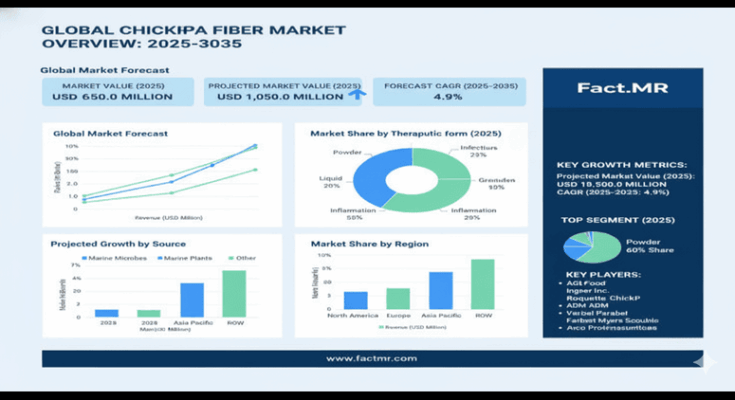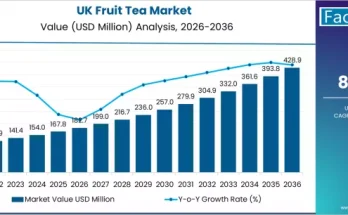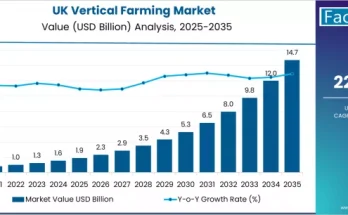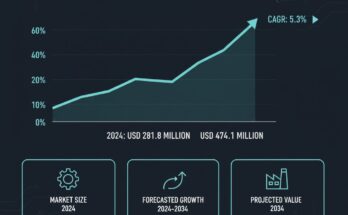The global Chickpea Fiber Market is entering a transformative decade. Valued at USD 650.0 million in 2025, the market is projected to reach USD 1,050.0 million by 2035, growing at a compound annual growth rate (CAGR) of 4.9%. This strong trajectory, adding nearly USD 400 million in new value, underscores rising industrial investment in functional food innovation, sustainable sourcing, and plant-based nutrition.
For forward-thinking manufacturers and ingredient suppliers, the Chickpea Fiber Market represents a powerful convergence of sustainability, innovation, and profitability.
Turning Waste into Value: The Circular-Economy Advantage
The modern food industry is redefining chickpea byproducts once considered waste. Advanced fractionation technologies are unlocking high-value fiber streams from chickpea hulls, transforming low-value residues into premium functional ingredients. This waste-to-value transformation aligns directly with the global shift toward sustainable, circular-economy production models.
These natural chickpea fiber ingredients deliver excellent water-binding, fat-replacement, and texture-enhancement properties — all while maintaining clean-label appeal. Unlike synthetic fibers, chickpea fiber retains its natural integrity and versatility, enabling food manufacturers to meet demand for minimally processed, functional, and sustainable ingredients.
Functional Versatility Driving Adoption
The Chickpea Fiber Market offers exceptional versatility. Chickpea-derived fiber supports moisture retention, mouthfeel improvement, and digestibility enhancement, making it a critical formulation component for bakery, snack, beverage, and functional supplement applications.
Clinical studies highlight chickpea fiber’s prebiotic properties, fostering beneficial gut bacteria such as Bifidobacteria and Lactobacilli. These scientifically supported health benefits position chickpea fiber as more than a bulk ingredient — it is now a science-driven nutritional enhancer that supports gut health, metabolic regulation, and immune performance.
Market Outlook: From Functional Foods to Premium Nutrition
Between 2025 and 2030, the Chickpea Fiber Market is expected to grow from USD 650 million to USD 825 million, contributing 43.8% of the total decade’s expansion. From 2030 to 2035, it will climb another USD 225 million to reach USD 1,050 million, supported by premium organic applications and plant-based nutrition programs.
Key growth sectors include:
-
Bakery applications (35% share in 2025) — driving demand for high-fiber, clean-label ingredients.
-
Snacks (30%) — supporting healthy snacking and nutritional reformulation.
-
Beverages (20%) — integrating chickpea fiber for texture and functional health claims.
Regional Insights: Asia Leads, Developed Markets Mature
Asia-Pacific leads the Chickpea Fiber Market expansion. India stands out with the highest CAGR of 5.8% through 2035, followed by China (4.8%), reflecting rapid adoption of plant-based nutrition in emerging economies. The United States (4.6%), Germany (4.4%), South Korea (4.2%), and Japan (4.0%) remain key markets with advanced manufacturing infrastructure and functional food innovation.
In India and China, government-backed nutritional programs and modernization of food processing facilities are accelerating chickpea fiber integration into mainstream food systems. Meanwhile, Europe and North America focus on premium fiber applications, organic certifications, and R&D partnerships.
Competitive Landscape: Innovation and Integration
The Chickpea Fiber Market remains moderately concentrated, with 15–20 significant players. Leading companies such as NutriPea, AGT Food, Ingredion, Roquette, ChickP, ADM, and Glanbia dominate through technological expertise, processing innovation, and strategic partnerships with global food manufacturers.
Competition is centered on fiber purity, processing efficiency, and application specialization, rather than price alone. Companies investing in advanced extraction technologies and custom fiber formulations are best positioned to capture premium growth segments.
Manufacturing Opportunities: Why Industry Leaders Are Paying Attention
For manufacturing giants, the Chickpea Fiber Market offers distinct strategic advantages:
-
Sustainability leadership: Aligning production with circular-economy goals.
-
Functional differentiation: Offering natural texture and fiber solutions without chemical modification.
-
Portfolio expansion: Entering high-growth bakery, snack, and beverage categories with validated functional ingredients.
-
Regional diversification: Investing in Asia-Pacific’s 5–6% CAGR markets for cost-efficient, scalable production.
-
Health and nutrition alignment: Targeting prebiotic and digestive-health segments with clinically supported benefits.
By 2035, manufacturers that embed chickpea fiber within their product portfolios can expect enhanced market credibility, improved ingredient sustainability metrics, and stronger alignment with consumer expectations for natural, nutrient-dense foods.
Browse Full Report: https://www.factmr.com/report/chickpea-fiber-market
Future Outlook and Key Trends
The next decade will see:
-
Technological breakthroughs in chickpea fiber extraction and purification.
-
Automated processing systems improving fiber uniformity and cost efficiency.
-
Collaborative R&D between chickpea fiber producers and global food brands.
-
Government incentives supporting plant-based food innovation and supply-chain resilience.
-
Expansion of organic chickpea fiber for premium product lines.
Despite supply-chain complexity and seasonal crop variability, robust investment in processing technology and sourcing infrastructure will ensure stable long-term growth.
Summary
| Metric | Value |
|---|---|
| Market Size (2025) | USD 650 million |
| Forecast Value (2035) | USD 1,050 million |
| CAGR (2025–2035) | 4.9% |
| Leading Form | Powder (≈70%) |
| Key Application | Bakery (35%) |
| High-Growth Region | India (5.8% CAGR) |
| Top Companies | NutriPea, AGT Food, Ingredion, Roquette, ChickP, ADM, Glanbia |



